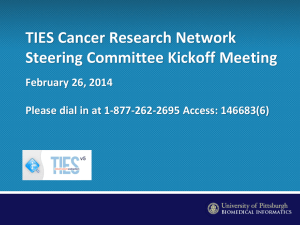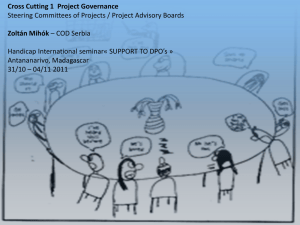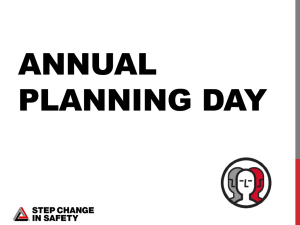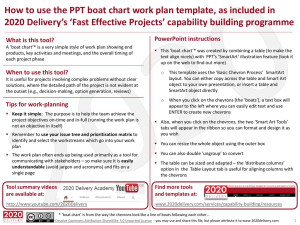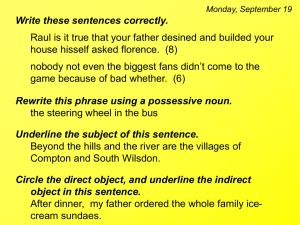High Volume Production Trial Project Report
advertisement
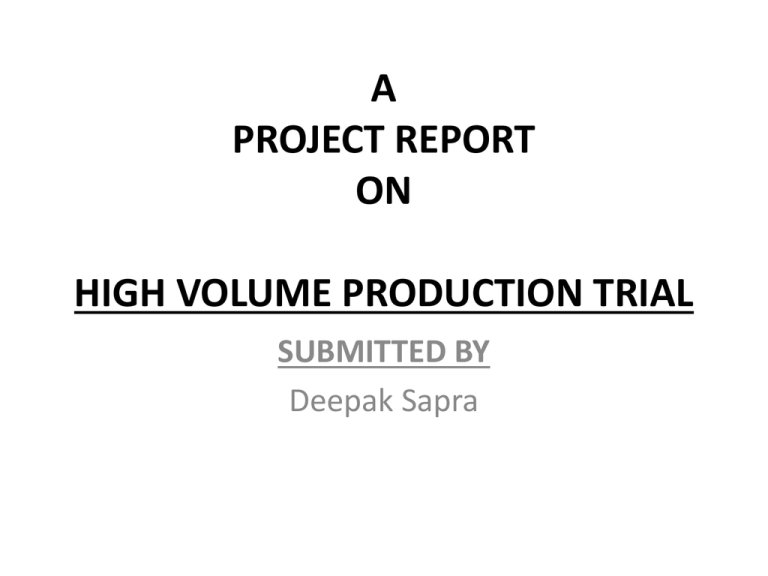
A PROJECT REPORT ON HIGH VOLUME PRODUCTION TRIAL SUBMITTED BY Deepak Sapra Index • • • • • • • • • • • S.No 1 2 3 4 5 6 7 8 9 10 Contents Company Profile Introduction to Plant Heat Treatment Paint Shop Testing Lab Steering System Effective Project Mgt Hvpt Process Flow Charts Comments Introduction • Sona Group • In the automative component industry, Sona is a name that stands for quality, dynamism, multifacated growth. With its beginning as a small company in 1897, now Sona group comprises company each of which are in joint venture partnership and technical and financial collaboration with global leaders in their specialist areas. The Sona group comprises five operating and two services organizations. • Sona is driving upon the strengths of its joint venture partners, which includes Koyo Seiko co. Japan; Mondo Korea; Mitsubishi Materials co. Japan; Somic Ishikawa, Japan; Fuji autotech, France& Fuji autotech AB, Sweden and ZF Lemforder, Germany to upgrade its systems, Skills, and Production values to offer its customers contemporary and high quality products. SONA KOYO-Patners of Choice • Sona koyo the flagship company of the Sona group is currently the largest manufacturer of steering systems for the passenger car and utility vehicles market in India, with a Market share of 45%. Its collaborator and partner Koyo Seiko Company limited, Japan, is the market leader in Japan and has recently announced a merger with Toyota Machine Works, making it number one steering systems manufacturer in the world. The company also has a technological collaboration with Ando Corporation, Korea. • The Deming Award, the world’s most coveted Honour for excellence in Total Quality Management was awarded to Sona Koyo on 11th November 2003 Sona koyo steering system ltd. is a technique and financial joint venture company of koyo Seiko Company, Japan—the global technology leader in steering systems. The company is the largest manufacturer of steering gears in India and is the leading supplier of— Hydraulic power steering system Manual rack and pinion steering system Collapsible, tilt and rigid steering columns for passengers vans and MUVs • • • • Customers India • • • • • • • • Maruti-Suzuki Toyota(India) HM-Mitsublshi Tata Motors Mahindra &Mahindra Swaraj Mazda Fiat Ashok Leyland • • • • • • • • Honda-Seil GM(India) Ford(India) Honda Motors Eicher-Mitsubuishi Punjab Tractors International Tractors Bajaj Tempo Overseas • • • • • Koyo Seiko (Japan,US) Lemforder(Germany) Mistibuishi Materials TMA Case New Holland • • • • • Arvin-Meritor Continental(US) Maval Manufacturing EZGO JCB Excavators Ltd. Company Performance, History & Plan • Sona Koyo Steering Systems Limited (SKSSL) is a technical and financial joint venture company of Koyo Seiko Company, Japan. The company is the largest manufacturer of steering gears in India. The company’s product range also extends to Rear Axle Assemblies and Propeller Shafts. The World Economic Forum named the company as a Global Growth Company in 1997. • SKSSL aims to achieve • Zero accidents • Zero defects • Zero breakdowns • “Commitment to defect prevention and continuous improvement while meeting or exceeding customer requirements at all times.” Future Plans • The management of the company has chalked out a plan known as Vision 2011. Salient features of the plan are as follows: – Vision 2011 looks ahead to maintain No. 1 position in the long run. – The present contribution of exports to the total turnover is a mere 2%. The company plans to increase it to as high as 45% of the total turnover by the year 2012. • From being a Rs. 250 crores company presently, the management wants to make it a Rs. 2000 crores by the end of the year 2011 Introduction to Plants • SKSSL has a total of four plants, each of which manufactures different products. Plant I manufactures RPS Assemblies, rigid columns collapsible columns and tilt steering assembly. Apart from the assemblies themselves, the various in-house parts like Rack, Pinion, Case gear etc. that are used in the manufacturing of these assemblies are made in Plant I. Apart from this, various other brought out parts (BOP) are used such as Bellow, Rack cover, Rack housing etc • Plant II is slightly bigger and manufactures a larger number of items than Plant I. The most important of the products manufactured here are the RBS Assemblies for various models, Propeller Shaft Assemblies and Axle Assemblies. In addition to these assemblies, the sector shaft assemblies that are used in the RBS Assemblies, the Slide Yoke and Flange Yoke Assemblies that are used in the Propeller Shaft Assemblies. Differential Assemblies that are used in the Axle Assemblies are also made in this plant. Various in-house products like the sector shaft, wormshaft, bevel gear, spider and ball-nut are made in Plant II. Plant III is also known as the Power Steering Plant and it started in 1998. The plant makes Power Steering Assemblies and has just an assembly line currently. Plant – I •Process 1)Pinion Soft 2) Pinion Hard 3) Rack Bar 4) Case Gear Assembly 5) RPS Assembly 6) Universal Joint a) Manual b) Automatic 7) Collapsible Column Plant ll • Process 1. Ball Nut Soft Line & Hard line 2. Worm Shaft Soft Line 3. Sector Shaft Soft Line & Hard Line 4. RBS Housing 5. RBS Assembly 6. Bevel Gears Manual and Automatic 7. Axle Assembly. Plant lll • Process 1. Cylinder Tube Machining 2. Rack Bar for Power Steering 3. Case gear for Power Steering 4. RPS Power Steering Assembly Heat Treatment Plant Quenching: This plant in SKSSL has three Sealed Quench Furnaces. Two of them are hot oil quench furnaces while the third one is cold oil one. • Tempering: It is the process of heating the components to be quenched at 160-170°C proceeds quenching. The process softens the material a bit so that it does not crack when used due to over hardness Central Lapping: This process is carried towards the end of the heat treatment cycle. Here, the preexisting holes are cleaned and chamfered. Shot Blasting: Shot blasting is a process to improve the surface finish of the components after heat treatment. Engineering Testing Lab • This lab is located in Plant II. The lab is operational all the time and testing of various components is done here periodically to make sure that the quality of the products is of utmost quality. The various tests carried out in the lab are: • Bellow Durability Test: To check for cracks, abrasions and breakage in the bellow while operating under very hot or very cold conditions. • Column Durability Testing: Here input is a rectangular waveform given from the handle side of the column. • Steering Column Impact Testing: In this test, a body block is attached to a linear actuator and through this system; a thrust is given to the steering column. Sufficient thrust is given to cause breakage of the column. STEERING COLUMN ASSEMBLY Steering Column: The steering column consists of the main steering shaft, which transmits the steering wheel rotation to the steering gear, and the column tube that fixes the steering main shaft to body. The top end of the steering main shaft is tapered and serrated, and a nut fits the steering wheel to it. The bottom end of the steering main shaft is connected to the steering gear, generally by way of a universal joint to minimize the transmission of road shock from the steering gear to the steering wheel. Steering Gear: The gears in the steering gears in the steering gear assembly not only steer the front wheels but, at the same time they act as reduction gears, reducing steering wheel turning effort by increasing the output torque. The reduction ratio is called the steering gear ratio and is normally between 18 and 20:1. A larger ratio reduces the steering effort but makes it necessary to turn the steering wheel more when going around a curve. There are various types of steering gear systems, but the rack-and-pinion type (RPS) and the recirculatingball type (RBS) are most commonly used on current vehicles. SONA KOYO STEERING SYSTEMS LIMITED (SKSSL) produces both types of steering systems Re-circulating ball screw type manual steering system High Volume Production Trial 1.Purpose; • Purpose of “High Volume Production Trial” (it is called “HVPT” hereafter) is to communicate the Product Quality Planning and Control Plan requirements as well as defining the procedure for conducting a High Volume Production Trial (HVPT) and to judge whether or not the mass production can be started for the line. This shall be conducted before Start of Production (“SOP”) for smoother launch of the new product. 2. Scope: This procedure shall be applied to item (1), however, for items (2) and (3) it can be applied according as this procedure, too. (1) The new product. (2) The product in mass production but the volume is greatly increased. (3) The mass production product but there is a quite big process change. 3. APQP: The supplier shall perform the activities specified in the Advanced Product Quality Planning and Control Plan (APQP) and maintain documented evidence of such activities. 4. Timing to implement: The supplier shall perform the HVPT to reduce the likelihood of any quality or quantity related problems occurring at the Start of Production (SOP) by simulating Mass Production conditions. I.) Pre-conditions for conducting HVPT II.) Check items to conduct the HVPT 5.Items to be checked during HVPT •Standardized Work; Has Standardized Work Chart (SWC) been provided? And are operators working as per SWC? 6. Implementation of HVPT 6.1) The Role of Leader for HVPT He must get together all people concerned, operators, and supervisors, others who concerned and must explain important points for HVPT. Give a signal for starting and finishing time for HVPT 6.2) The Role of Time Keeper To keep record of the time and happenings those are observed during HVPT. 7.Meeting after HVPT After HVPT the Leader must hold a meeting with concerned people, Time keeper, etc. and discuss and/or confirm the followings •Evaluate each items of No.5, above mentioned. (2) Make summary sheet for Problems and Action plan for countermeasures and/or improvement against observations during HVPT. See attached format. (Action plan shall be posted near the line and to be followed-up.) (3) In case of NG for HVPT judgment, decide the date for re-HVPT. Comments •All countermeasures related to Quality and Safety should be closed before start of mass production. •HVPT should focus on meeting peak volume requirement of the customer.
